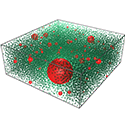Drying out in 3D
Mixtures of immiscible fluids with colloids can be very complex but they are technologically important for industries such as paints and protective coatings, especially when such materials undergo drying. Emulsions containing colloidal particles are particularly interesting as controllable test cases of such systems, but they are difficult to image because these mixtures typically scatter light strongly. Lei Xu at The Chinese University of Hong Kong and colleagues in the US, France, Switzerland, UK, and Japan now report in Physical Review Letters their ability to create a full 3D picture of what happens when these emulsions dry out.
The authors mixed a suspension of polymethylmethacrylate spheres (dyed green) in decahydronaphthalene with an aqueous emulsion of water and glycerol, plus a surfactant to stabilize the water droplets (dyed red). Pictures of this concoction were obtained with a confocal microscope, which captures very thin slices of the sample that can be built up into high-resolution 3D images. As the mixture dries on a microscope slide, two different behaviors emerge: large droplets evacuate quickly, whereas small droplets undergo shape changes yet remain essentially intact. A simple model allows the authors to calculate the threshold radius for evaporation, and with this technique they have been able to create a new class of hierarchical materials. – David Voss





